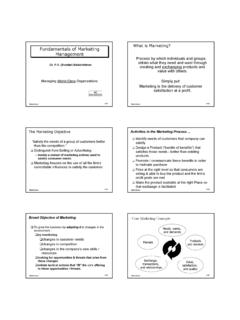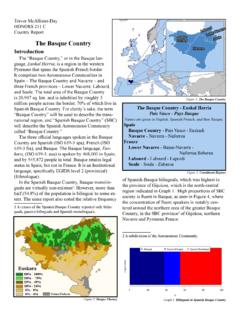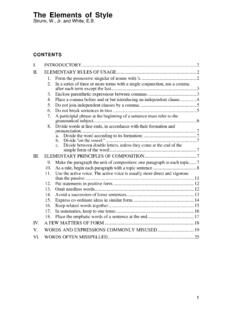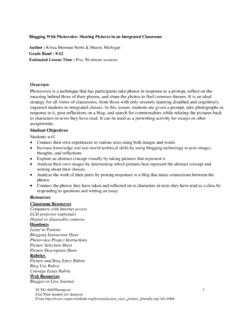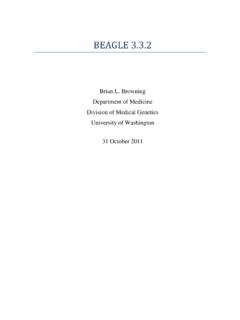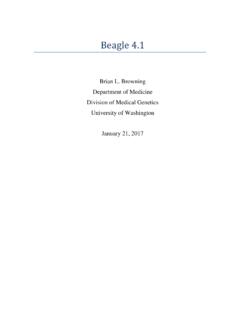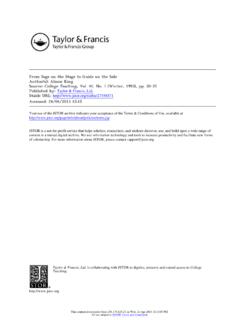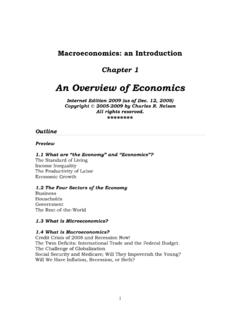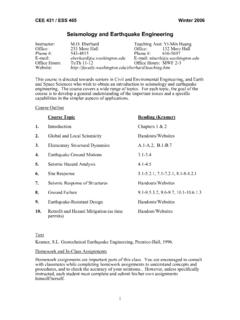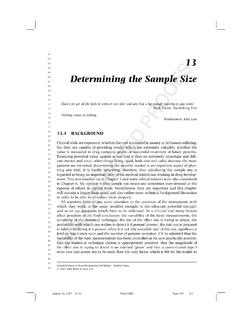Transcription of Sample Size Calculations for Randomized Controlled Trials
1 Sample size Calculations for Randomized Controlled TrialsJanet WittesINTRODUCTIONMost informed consent documents for Randomized con-trolled Trials implicitly or explicitly promise the prospectiveparticipant that the trial has a reasonable chance of answer-ing a medically important question. The medical literature,however, is replete with descriptions of Trials that providedequivocal answers to the questions they addressed. Papersdescribing the results of such studies may clearly imply that thetrial required a much larger Sample size to adequately addressthe questions it posed. Hidden in file drawers, undoubtedly, aredata from other Trials whose results never saw the light ofday some, perhaps, victims of inadequate Sample size . Al-though many inadequate-sized studies are performed in a sin-gle institution with patients who happen to be available, someare multicenter Trials designed with overly optimistic assump-tions about the effectiveness of therapy, too high an estimate ofthe event rate in the control group, or unrealistic assumptionsabout follow-up and this review, I discuss statistical considerations in thechoice of Sample size and statistical power for randomizedcontrolled Trials .
2 Underlying the discussion is the view thatinvestigators should hesitate before embarking on a trial thatis unlikely to detect a biologically reasonable effect oftherapy. Such studies waste both time and number of participants in a Randomized controlledtrial can vary over several orders of magnitude. Rather thanchoose an arbitrary Sample size , an investigator shouldallow both the variability of response to therapy and theassumed degree of effectiveness of therapy to drive thenumber of people to be studied in order to answer a scien-tific question. The more variable the response, the larger thesample size necessary to assess whether an observed effectof therapy represents a true effect of treatment or simplyreflects random variation. On the other hand, the moreeffective or harmful the therapy, the smaller the trial re-quired to detect that benefit or harm. As is often pointed out,only a few observations sufficed to demonstrate the dra-matic benefit of penicillin; however, few therapies providesuch unequivocal evidence of cure, so study of a typicalmedical intervention requires a large Sample size .
3 Lack ofresources often constrains Sample size . When they are lim-ited by a restricted budget or a small patient pool, investi-gators should calculate the power of the trial to detectvarious outcomes of interest given the feasible Sample trial with very low statistical power may not be first Trials of a new drug include only a handful ofpeople. Trials that study the response of a continuous vari-able to an effective therapy for example, blood pressurechange in response to administration of an antihypertensiveagent may include several tens of people. Controlled trialsof diseases with high event rates for example, Trials oftherapeutic agents for cancer may study several hundredpatients. Trials of prevention of complications of disease inslowly progressing diseases such as diabetes mellitus mayenroll a few thousand people. Trials comparing agents ofsimilar effectiveness for instance, different thrombolyticinterventions after a heart attack may include tens of thou-sands of patients.
4 The poliomyelitis vaccine trial includedapproximately a half-million participants (1).This review begins with some general ideas about ap-proaches to calculation of Sample size for Controlled then presents a generic formula for Sample size that can bespecialized to continuous, binary, and time-to-failure vari-ables. The discussion assumes a Randomized trial comparingtwo groups but indicates approaches to more than twogroups. An example from a hypothetical Controlled trial thattests the effect of a therapy on levels of high densitylipoprotein (HDL) cholesterol is used to illustrate each introduced a basic formula for Sample size , thereview discusses each element of the formula in relation toits applicability to Controlled Trials and then points to specialcomplexities faced by many Controlled Trials how the useof multiple primary endpoints, multiple treatment arms, andsequential monitoring affects the type I error rate and hencehow these considerations should influence the choice ofsample size ; how staggered entry and lag time to effect oftherapy affect statistical power in studies with binary ortime-to-failure endpoints; how noncompliance with pre-scribed therapy attenuates the difference between treatedgroups and control groups; and how to adjust Sample sizeduring the course of the trial to maintain desired power.
5 Thereview discusses the consequences to Sample size calcula-tion of projected rates of loss to follow-up and competingrisks. It suggests strategies for determining reasonable val-ues to assume for the different parameters in the , the review addresses three special types of studies:equivalence Trials , multiarm Trials , and factorial of Sample size is fraught with imprecision,Received for publication November 1, 2001, and accepted forpublication April 16, : HDL, high density Statistics Collaborative, Inc., 1710 Rhode Island (Reprint requests to Dr. Janet Wittes at this ad-dress).Epidemiologic ReviewsVol. 24, No. 1 Copyright 2002 by the Johns Hopkins Bloomberg School of Public HealthPrinted in rights reserved39for investigators rarely have good estimates of the basicparameters necessary for the calculation . Unfortunately, therequired size is often very sensitive to those unknownparameters. In planning a trial, the investigator should viewthe calculated Sample size as an approximation to the nec-essary size .
6 False precision in the choice of Sample size addsno value to the design of a investigator faces the choice of Sample size as one ofthe first practical problems in designing an actual controlledtrial. Similarly, in assessing the results of a published con-trolled trial, the critical reader looks to the Sample size tohelp him or her interpret the relevance of the results. Otherthings being equal, most people trust results from a largestudy more readily than those from a small one. Note that intrials with binary (yes/no) outcomes or Trials that study timeto some event, the word small refers not to the number ofpatients studied but rather to the number of events trial of 2,000 women on placebo and 2,000 on a newtherapy who are being followed for 1 year to study the newdrug s effect in preventing hospitalization for hip fractureamong women aged 65 years is small in the parlance ofcontrolled Trials , because, as data from the National Centerfor Health Statistics suggest, only about 20 events are ex-pected to occur in the control group.
7 The approximately 99percent of the Sample who do not experience hip fractureprovide essentially no information about the effect of observation that large studies produce more widelyapplicable results than do small studies is neither particu-larly new nor startling. The participants in a small studymay not be typical of the patients to whom the results are toapply. They may come from a single clinic or clinicalpractice, a narrow age range, or a specific socioeconomicstratum. Even if the participants represent a truly randomsample from some population, the results derived from asmall study are subject to the play of chance, which mayhave dealt a set of unusual results. Conclusions made froma large study are more likely to reflect the true effect oftreatment. The operational question faced in designing con-trolled Trials is determining whether the Sample size issufficiently large to allow an inference that is applicable inclinical Sample size in a Controlled trial cannot be arbitrarilylarge.
8 The total number of patients potentially available, thebudget, and the amount of time available all limit the numberof patients that can be included in a trial. The Sample size ofa trial must be large enough to allow a reasonable chance ofanswering the question posed but not so large that continu-ing randomization past the point of near-certainty will leadto ethical discomfort. A data monitoring board charged withensuring the safety of participants might well request earlystopping of a trial if a study were showing a very strongbenefit of treatment. Similarly, a data monitoring board isunlikely to allow a study that is showing harm to partici-pants to continue long enough to obtain a precise estimate ofthe extent of that harm. Some boards request early stoppingwhen it is determined that the trial is unlikely to show adifference between literature contains some general reviews and discus-sions of Sample size Calculations , with particular referenceto Controlled Trials (2 8).
9 GENERAL CONSIDERATIONSC alculation of Sample size requires precise specificationof the primary hypothesis of the study and the method ofanalysis. In classical statistical terms, one selects a nullhypothesis along with its associated type I error rate, analternative hypothesis along with its associated statisticalpower, and the test statistic one intends to use to distinguishbetween the two hypotheses. Sample size calculation be-comes an exercise in determining the number of participantsrequired to achieve simultaneously the desired type I errorrate and the desired power. For test statistics with well-known distributional properties, one may use a standardformula for Sample size . Controlled Trials often involvedeviations from assumptions such that the test statistic hasmore complicated behavior than a simple formula to follow-up, incomplete compliance with therapy,heterogeneity of the patient population, or variability inconcomitant treatment among centers of a multicenter trialmay require modifications of standard formulas.
10 Many pa-pers in the statistical literature deal with the consequences tosample size of these common deviations. In some situations,however, the anticipated complexities of a given trial mayrender all available formulas inadequate. In such cases, theinvestigator can simulate the trial using an adequate numberof randomly generated outcomes and select the Sample sizeon the basis of those computer studies often benefit from a three-step strat-egy in calculating Sample size . First, one may use a simpleformula to approximate the necessary size over a range ofparameters of interest under a set of ideal assumptions ( ,no loss to follow-up, full compliance, homogeneity of treat-ment effect). This calculation allows a rough projection ofthe resources necessary. Having established the feasibilityof the trial and having further discussed the likely deviationsfrom assumptions, one may then use more refined calcula-tions. Finally, a trial that includes highly specialized fea-tures may benefit from simulation for selection of a moreappropriate , for example, a trial comparing a new treatmentwith standard care in heart-failure patients.
